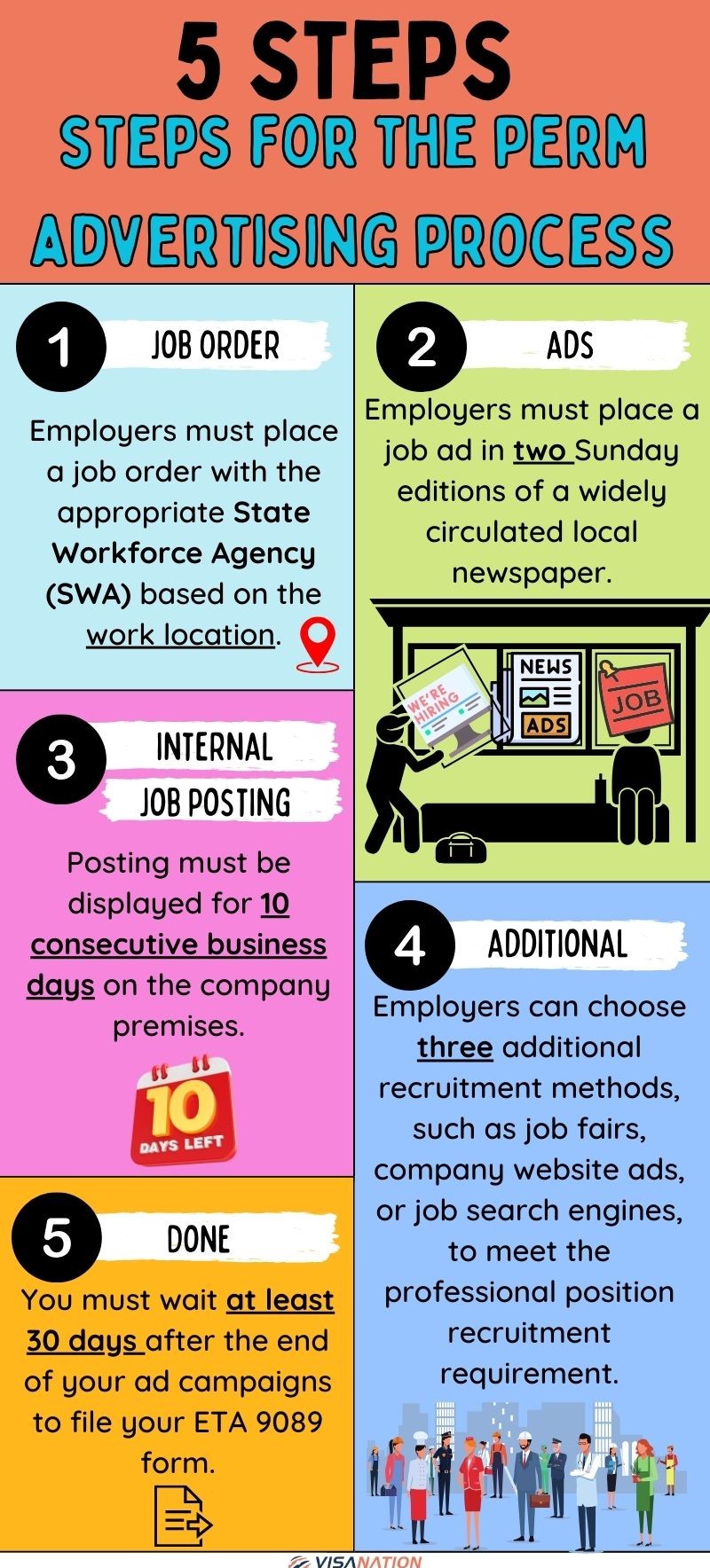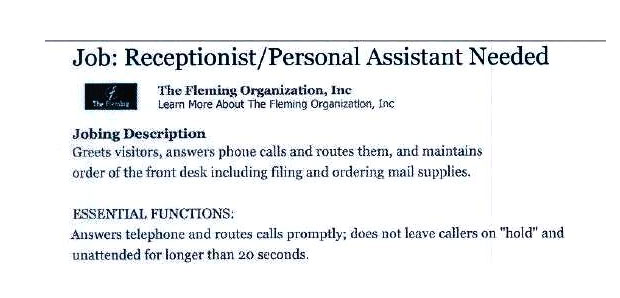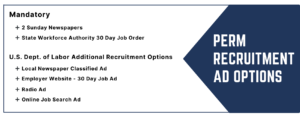For many work visas and employment-based green cards, the first step is to obtain a PERM labor certification from the Department of Labor (DOL), which requires an extensive PERM advertising process. These procedures exist to ensure that employers are not taking advantage of the immigration system to deprive qualified U.S. workers of potential jobs.
In this guide, you’ll learn all about the PERM advertising process, requirements, timeline, and other key information.
PERM Advertising Requirements
Employers must carefully follow through on the PERM advertising process based on DOL compliance, including:
- Placing a job order with the State Workforce Agency (SWA) for 30 days
- Placing a job ad in two Sunday editions of a widely circulated local paper
- Three additional methods, such as a job fair, company website, or job search engine
- Internal notice of filing – post at worksite for 10 consecutive business days
- Waiting at least 30 days after the job order ends before filing ETA 9089
In this guide, you’ll learn the PERM advertising process, requirements, timeline, and other key information.

If the DOL suspects that the advertising process was not completed satisfactorily, then you may be subject to a targeted audit. This can seriously delay the processing time of your employee’s work visa or green card. While some audits are random and therefore unavoidable, following the PERM advertising process carefully can help mitigate the chances of being targeted by the DOL.
PERM Advertising Process
Below are the mandatory PERM recruitment steps required for both professional and nonprofessional occupations. Note that this process aims to cover all of the major avenues by which workers seek employment so that the DOL can be reasonably sure that you have made a legitimate effort to find a suitable U.S. worker to fill your position.
1. Prevailing Wage Determination
The first thing that should be done before embarking on the PERM recruitment and advertising process is to determine the prevailing wage for the offered position. This is the wage that the DOL has determined to be appropriate for this particular position in your geographic location.
You must ensure that if your job advertisements display the wage, it is not lower than the prevailing wage. This is especially important for the Notice of Filing, as you will see further on in this article.
2. Place a Job Order
Employers are required to place a job order with the appropriate State Workforce Agency (SWA). This job order must be placed with the state workforce agency that corresponds to the state in which the work will take place.
For example, if you are an employer located in California that has a position open in a branch in Texas, then you must place the job order with the Texas workforce agency instead of the California workforce agency.
Job Order Posting Requirements
-
- The job order must run for at least 30 consecutive calendar days, which includes weekends.
- Many employers extend the posting by a few extra days to avoid potential issues with miscounting or technical errors.
30-Day Waiting Period
- After the job order ends, you must wait at least 30 additional calendar days before filing the ETA 9089 form..
This waiting period allows time for U.S. workers to apply and be considered for the position.
Example Advertising Timeline
- If the job order ran from January 1 to January 31, the 30-day waiting period would run from February 1 to March 2.
- The earliest you could file the ETA 9089 would be March 3.
The reasoning behind this PERM filing process is to allow potential U.S. job applicants the opportunity to be considered for the position after the job order has been placed.
As with many of the documents related to the PERM ad requirements, we recommend you keep printed copies of the SWA’s job posting as part of your PERM labor process documents.
3. Ads in Newspaper/Professional Journals
You are required to place a job ad in two Sunday editions of a local newspaper with wide circulation in the area of intended employment. So, if the position will take place in Miami, your ad should be in the Miami Herald or a paper with similar recognition.
If the position is in a rural area that does not have a Sunday edition, the employer should use the newspaper that has the widest circulation.
The PERM advertising requirements state that the ad must include:
- Your business name
- Instructions detailing where applications and resumes should be sent
- A general overview of the position that gives potential applicants a good idea of what is entailed
- Possible mitigating factors such as job location and/or travel percentages
4. Internal (in-house) Job Posting
Also known as a notice of filing (NOF), an internal job posting should be posted for 10 consecutive business days on your company’s physical premises. If it’s a union position, proper notice must be given to the representative.
The NOF needs to include very specific language that alerts your current employees that you are in the process of obtaining a PERM Labor Certification. This must also allow them to submit documentary evidence that has a bearing on the application.
According to the regulations, it must contain the following information:
- Business name and location
- General job description
- Wages and other compensation
- Your contact information, including an address to send resumes
It is important not to ignore or forget this step, as it can be the difference between the success or failure of your application. Working alongside a qualified immigration lawyer can help ensure that this aspect is not overlooked and is satisfactorily completed.
Looking for support with the PERM process? VisaNation’s legal team can provide expert guidance through every step
PERM Notice of Filing Denial
Here are some common reasons why your PERM may be denied on account of the NOF:
- Failing to include basic information such as the employer’s name, the wage for the position, or the location of the position (even if the location is the place in which the NOF is posted)
- Neglecting to add the NOF posting dates to your PERM recruitment report
- Not including the address of the Certifying Officer that is overseeing your case
- Having job requirements or other information that differs from the ETA 9089
Incomplete or inconsistent information is one of the easiest ways to be audited or to have your application denied. To protect the efforts you’ve made in the PERM recruitment process, make sure to pay attention to every detail and follow the instructions carefully. The DOL is not open to entertaining any arguments for why their rules were not upheld.
5. Additional PERM Ad Requirements
On top of the above requirements, an employer can choose a combination of any 3 additional recruitment methods outlined below to meet the additional recruitment requirement for professional positions:
- Participation in a job fair that has a high likelihood of bringing in applicants that are qualified for your position
- Posting an ad on the company’s website. Be sure to keep a record of the Internet screenshots taken of these ads
- Using a job search engine other than your own company’s website, such as Monster.com or Indeed.com
- Participation in on-campus recruiting if the job does not require several years of relevant experience
- Placing an advertisement with a trade or professional organization. This could involve advertising in a relevant academic or professional journal
- Using the services of a private employment firm. Be sure to keep copies of all contracts and correspondence between you and this firm
- Incentivizing employees to refer new recruits through rewards or benefits such as bonuses or vacation days
- Placing an ad with a local college’s campus placement office
- Posting an ad in the local and ethnic newspapers of the relevant work area
- Taking advantage of radio and television advertisements (to prove that this ad took place, keep a record of all contracts and payments made between you and the advertising station)
It is important to note that each of these ads can have a PERM advertising duration of any length of time, whether it be just one day or several. The choice is up to you.
However, you must wait at least 30 days after the end of your ad campaigns to file your ETA 9089 form. Because of this, it is often advisable to run the job order, notice of filing, and all ads as concurrently as possible to avoid unnecessary delays.
Here is a PERM recruitment advertising sample that was posted online containing the information required in each ad:

Note: You don’t need to include every minute detail about the job within the advertisement, but it should be thorough and include the basics like the name of the employer, address, contact information, and job outline. You are not required to include the wage in the advertisement. However, if you include it, it must not be lower than the Prevailing Wage Determination.
Non-Professional PERM Advertising Requirements
Non-professional positions are only required to fulfill two of the steps. Those include placing a job order with the State Workforce Agency (for 30 days) and placing the job ad in 2 consecutive Sunday newspapers.
PERM Timeline:
-
Prevailing wage determination: Takes about 6 months
-
Recruitment Period:
- Job Order: 30 days
- Sunday Newspaper Ads: 2 Sundays
- Internal Posting: 10 consecutive business days
- Additional Recruitment: 30 to 180 days before filing
-
Quiet Period – 30-day waiting period after completing recruitment efforts before filing the PERM application.
-
PERM Filing:
- PERM Processing: About 6 months for non-audit cases.
- Audit Processing: May take longer.
- Total: 12–18 months
PERM Requirements for EB2 Green Cards
If you are an employer looking to sponsor someone for an EB-2 green card, PERM Labor Certification will most likely be required. However, there are certain situations in which an applicant can self-petition through the use of a National Interest Waiver (NIW), which excuses the applicant from needing a job offer or a PERM.
To obtain an NIW, the applicant must be starting or investing in an enterprise that the USCIS deems as having a substantial positive impact on the national society, economy, or culture. The applicant must also prove that requiring a PERM in this situation would not benefit the national interest.
If you are a prospective EB-2 green card applicant and you believe that you may qualify for an NIW, talk with your immigration lawyer to learn about the steps you need to take.
PERM Recruitment After Advertising
Once the job has been advertised, the employer is responsible for interviewing the candidates who have met the requirements, including U.S. citizens. Should the employer reject U.S. citizen applicants, then you must document the reason for this in the recruitment report.
The reason should be lawful and non-discriminatory. All recruitment must be conducted within the 180 days before filing the labor certification application and must be completed at least 30 days before submitting the ETA 9089 form.
Due to the complexity of PERM recruitment and advertising, it’s best to consult an immigration attorney to ensure the proper steps are being followed.

Documents Required From the Employer – PERM Recruitment Report
To comply with PERM requirements, the employer must maintain paper documentation for each step of the process:
General Documentation
Keep copies of:
- Resumes and applications
- Recruitment reports
- Interview records
PERM Recruitment Report Details
- Include the number of hires and the number of U.S. workers not hired.
- There needs to be enough detail about the rejected U.S. workers for an auditor to scan if that occurs.
- Remember, the DOL’s goal is to ensure that no foreign worker is displacing a qualified U.S. worker. Keep this in mind when documenting the reasons for rejecting workers in your PERM recruitment report.
Proof of Advertising and Recruitment Efforts
Also, as stated before, you should keep a meticulous record of all correspondence, contracts, and payment receipts concerning your ad campaigns to provide sufficient proof that you took the necessary measures to find a qualified U.S. job applicant.
It is also important for your PERM recruitment report to perfectly match the information given on the ETA-9089 and the Notice of Filing to be posted in your place of business.
Boundaries When Rejecting U.S. Workers
There needs to be clear and lawful evidence for rejecting a U.S. worker. As the employer, you need to judge whether the U.S. applicant could fill the job with a reasonable amount of on-the-job training (if necessary). An employer is not required to hire a U.S. worker if they lack essential skills and would require significant training to perform the job.
PERM Advertising Services
There are online services/PERM advertising agencies that you can utilize to strategically place advertisements that will maximize your DOL approval rates. You can often save time and expedite the entire process by enlisting one of these services.
They will ensure that your ads appear in local or national newspapers (with sufficient circulation), on trade association boards, on online job boards, and more. From there, they will provide documentation to show that the position was posted so that it meets DOL requirements.
Be sure that the service you choose is DOL compliant, communicates openly about when postings will be made, and provides you with an industry standard tear sheet/printouts for all print, radio, and online ads.
Your attorney may know of some reputable service providers, or you can type ‘PERM advertising services’ into a search engine to see options.
PERM Advertising Cost
The PERM advertising cost will vary from one service to the next and based on your particular needs as well. Payment plans may be available depending on the service provider. In many instances, you can request a free quote along with recruitment options.
Learn about the PERM Supervised Recruitment Process and Requirements.
Frequently Asked PERM Questions
Below, you will find answers to the most commonly asked questions about PERM advertising.
What is PERM advertising?
Advertising the job position is a crucial step in the PERM process. The main objective is to vet the employer to make sure that hiring foreign talent does not displace domestic workers who could otherwise occupy the position.
How long is PERM advertising?
The job ad needs to be active for at least 30 consecutive days (including weekends).
How can I handle a PERM denial after audit?
You have a few options, which include filing a motion to reconsider or a request for review. The most appropriate course of action is best handled by your attorney. Learn more in this PERM denial after audit guide.
What does PERM stand for?
It stands for Program Electronic Review Management.
Can I get promoted during the PERM process?
Discuss this with your attorney but generally, changing the job description or wages is not advised.
What is the prevailing wage determination?
The PWD is the wage that the U.S. DOL has deemed to be appropriate for this particular position in your geographic location.
What form needs to be filed for a prevailing wage determination?
In order to request a PWD for an H-1B, PERM, H-1-B1, H-2B or E-3, you’ll need to file Form ETA-9141.
What wage sources can be used for the H1B1, H1 or E3?
The employer can choose between using the wage source from either the prevailing wage determination from the NPWC, a survey carried out by an independent organization or another reputable source. As a general rule, getting the prevailing wage determination from the NPWC is the safest bet in case you are ever audited for complying with it.
How We Can Help You
PERM advertising and recruitment can be a complex process if not handled correctly. VisaNation attorneys have a solid understanding of the regulations and can guide you through the entire process from beginning to end. If you have any further questions regarding the PERM advertising requirements or process, feel free to schedule a consultation.

